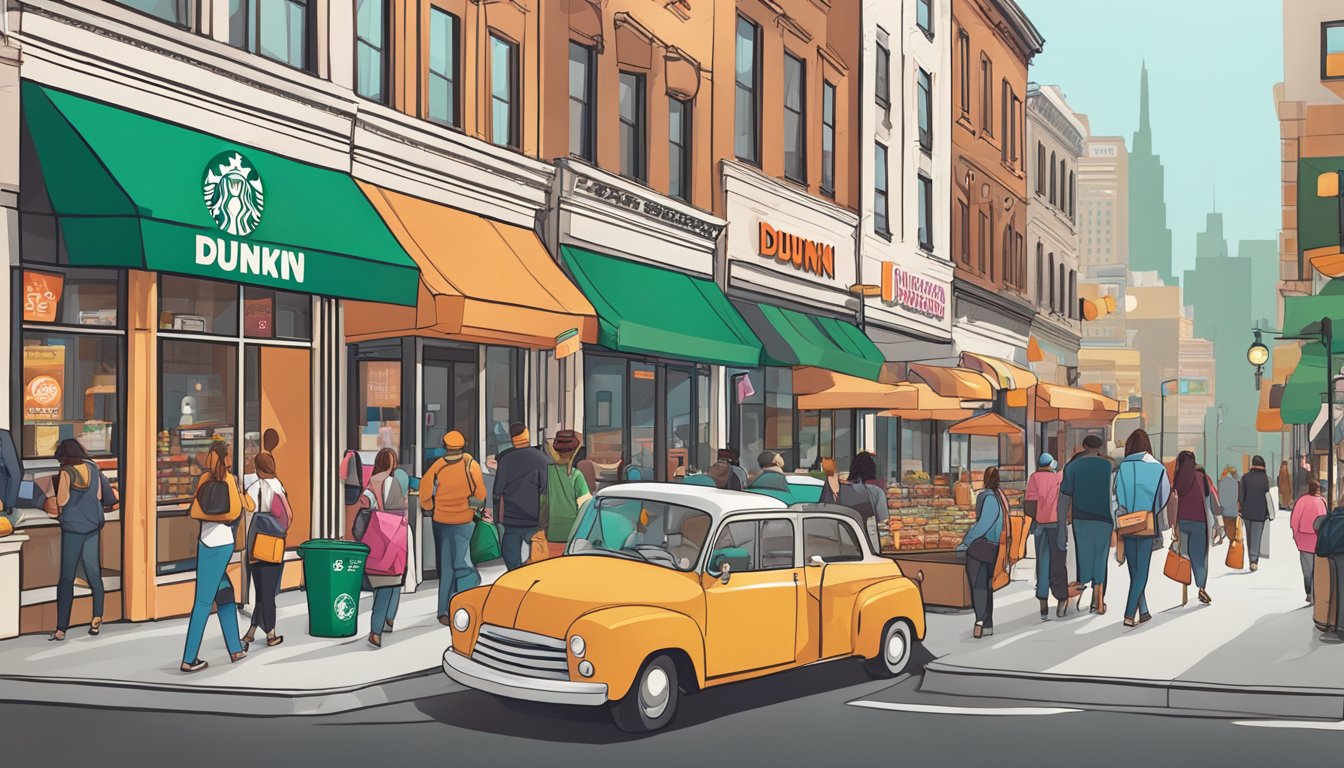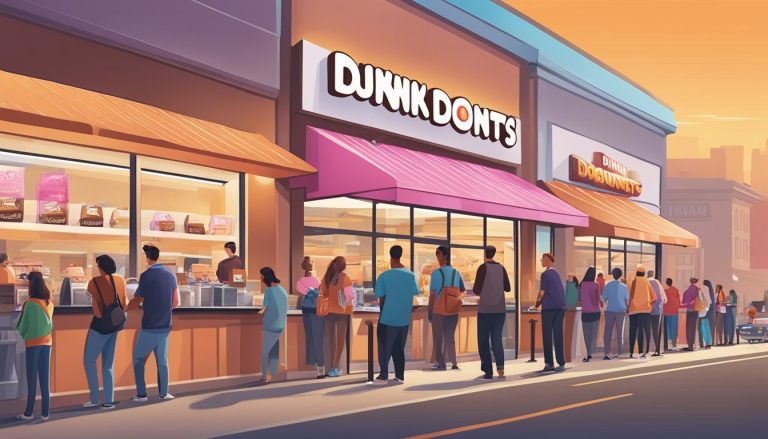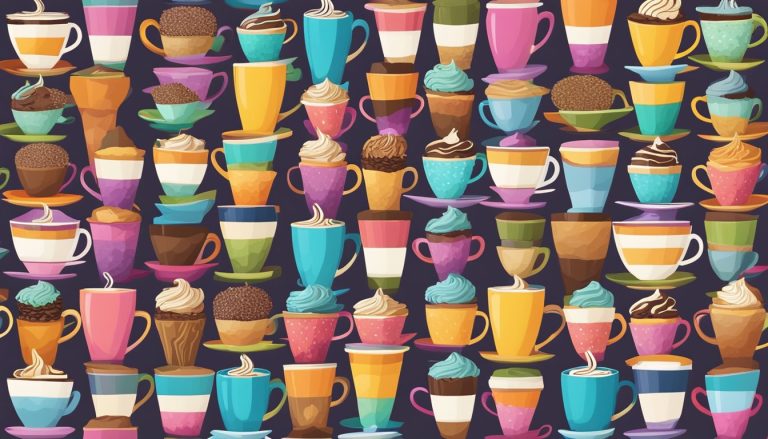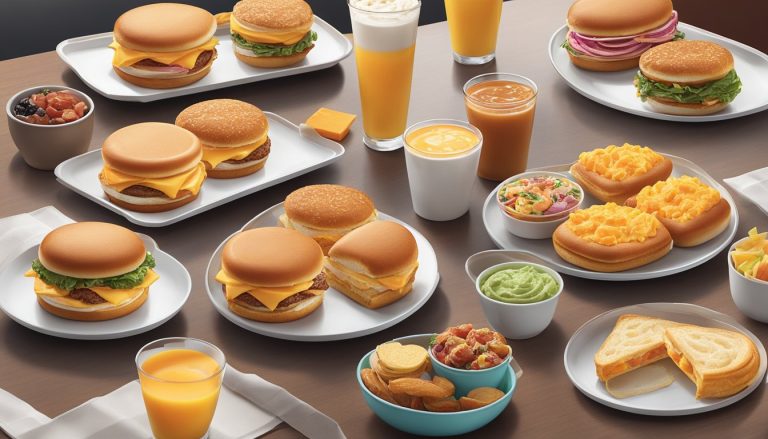Dunkin’ and Starbucks stand as two titans in the coffee industry, each carving out its own niche in the hearts and wallets of caffeine enthusiasts worldwide. These coffee giants have transformed morning routines and redefined the concept of grab-and-go breakfast for millions of customers.
Starbucks boasts over 20,000 stores across 65 countries, while Dunkin’ operates nearly 11,000 locations in 33 countries. Both chains have cultivated loyal followings, but their approaches to coffee, food, and customer experience differ significantly.
The battle between these breakfast behemoths extends beyond just coffee. From pricing strategies to brand perception, Dunkin’ and Starbucks offer distinct experiences that cater to different consumer preferences. Their ongoing rivalry has shaped the coffee landscape and continues to influence trends in the industry.
Company Overviews
Dunkin’ and Starbucks dominate the coffee and breakfast market, each with distinct approaches and impressive reach. These industry leaders have shaped American coffee culture through their widespread presence and unique offerings.
Dunkin’ at a Glance
Dunkin’ operates nearly 11,000 restaurants across 33 countries, with about 7,000 locations in the United States. The brand focuses on quick service and affordable options, appealing to customers seeking a speedy morning routine.
Dunkin’ generates significant revenue from its breakfast and coffee sales, with 60% of transactions occurring before 11 AM. The company’s menu features a variety of donuts, breakfast sandwiches, and coffee drinks at competitive prices.
Known for its slogan “America Runs on Dunkin’,” the brand has cultivated a loyal customer base attracted to its no-frills, efficient service model.
Starbucks: An Introduction
Starbucks boasts a larger global footprint with 20,000 retail stores in 65 countries, including 11,000 in the United States. The company positions itself as a premium coffee experience, emphasizing quality and atmosphere.
Starbucks’ business model extends beyond morning coffee runs, with over 50% of sales occurring after noon. The chain offers a wide range of customizable beverages, food items, and a comfortable environment for work and socializing.
The company’s success stems from its focus on creating a “third place” between home and work, fostering customer loyalty through its rewards program and seasonal offerings. Starbucks consistently ranks among the top coffee chains in terms of annual revenue and market share.
Product Offerings
Dunkin’ and Starbucks offer distinct beverage and food menus tailored to their brand identities. Their product lineups showcase unique specialties and cater to different customer preferences.
Beverage Assortment
Starbucks boasts an extensive coffee menu featuring espresso-based drinks, cold brew, and Frappuccinos. Their lattes come in various flavors, from classic vanilla to seasonal offerings like pumpkin spice. Starbucks also provides non-coffee options such as teas, refreshers, and smoothies.
Dunkin’ focuses on drip coffee and iced coffee varieties. They offer espresso drinks like lattes and cappuccinos, but with fewer customization options than Starbucks. Dunkin’s signature beverage is the Coolatta, a frozen drink available in coffee and fruit flavors.
Both chains serve hot and iced teas, but Starbucks typically offers a wider selection of tea-based beverages.
Food Items and Snacks
Dunkin’ is known for its donuts, with a rotating selection of flavors and seasonal specials. They also serve breakfast sandwiches, bagels, and muffins. Lunch options include sandwiches and wraps.
Starbucks offers a more upscale food menu. Their selection includes pastries, breakfast sandwiches, and protein boxes. They also provide healthier choices like oatmeal and yogurt parfaits.
Both chains have expanded their food offerings in recent years to include more substantial meal options. Starbucks tends to focus on premium ingredients and trendy flavors, while Dunkin’ emphasizes classic breakfast fare and grab-and-go snacks.
Consumer Experience
Starbucks and Dunkin’ offer distinct customer experiences, shaping their brand identities and loyal followings. From store atmospheres to digital engagement strategies, each chain takes a unique approach to serving coffee lovers.
In-Store Atmosphere
Starbucks cultivates a “third space” concept, providing a cozy retreat between home and work. Comfortable seating, soft lighting, and acoustic music create an inviting ambiance. Stores feature sleek designs with natural materials and local art, encouraging customers to linger.
Dunkin’ focuses on efficiency and speed. Bright colors, simple layouts, and counter seating cater to on-the-go customers. The atmosphere is lively and energetic, reflecting the brand’s emphasis on quick service and value.
Both chains train staff to deliver friendly service, but Starbucks baristas often engage in more personalized interactions. Dunkin’ prioritizes rapid transactions to keep lines moving swiftly.
Digital Engagement
Starbucks leads in mobile technology with its widely-adopted rewards app. Users earn stars, place orders, and pay through the platform. The app offers personalized promotions and drink recommendations based on purchase history.
Dunkin’s mobile app provides similar functionality but with a simpler interface. It emphasizes fast pickup options and location-based offers. Both chains use their apps to drive customer loyalty and gather valuable data on preferences.
Social media engagement differs between the brands. Starbucks cultivates a premium image through artful content and lifestyle posts. Dunkin’ takes a more playful approach, using humor and pop culture references to connect with its audience.
Marketing and Brand Positioning
Dunkin’ and Starbucks employ distinct marketing approaches and brand identities to capture market share. Their advertising strategies and brand positioning reflect their unique value propositions and target audiences.
Advertising Strategies
Dunkin’ focuses on affordability and convenience in its marketing campaigns. The company often highlights its wide range of food options alongside coffee, appealing to customers seeking quick, on-the-go meals. Their ads frequently feature everyday people and emphasize value.
Starbucks, in contrast, markets itself as a premium coffee experience. Their advertising showcases high-quality beans, skilled baristas, and customizable drinks. The company also promotes its commitment to ethical sourcing and sustainability.
Both chains utilize social media and digital marketing to engage customers and drive loyalty. Dunkin’ leverages playful content and promotions, while Starbucks emphasizes its artisanal coffee craftsmanship.
Brand Identity
Dunkin’ positions itself as an accessible, friendly brand for the masses. Its slogan “America Runs on Dunkin'” reflects its everyman appeal. The brand’s bright colors and casual atmosphere reinforce this image.
Starbucks cultivates a more upscale, sophisticated identity. Its green mermaid logo is instantly recognizable worldwide. The company aims to be a “third place” between home and work, offering a comfortable environment for customers to relax or work.
Dunkin’ emphasizes speed and efficiency in its customer service. Starbucks, however, focuses on personalized interactions and barista expertise. These differing approaches shape each brand’s reputation and customer loyalty.
Operational Strategies

Dunkin’ and Starbucks employ distinct operational approaches to maintain their market positions and fuel growth. Their strategies encompass supply chain management, ethical sourcing, and expansion tactics.
Supply Chain and Ethical Sourcing
Starbucks prioritizes ethical sourcing, partnering with farmers to ensure sustainable practices. The company has committed to 100% ethically sourced coffee by 2025.
Dunkin’ focuses on cost-effective supply chain management. They work with suppliers to maintain consistent quality while keeping prices competitive.
Both companies have invested in technology to streamline operations. Starbucks uses AI to predict demand and optimize inventory. Dunkin’ has implemented a mobile ordering system to reduce wait times.
Growth and Expansion Tactics
Starbucks pursues aggressive international expansion, particularly in China. They adapt store designs and menus to local preferences while maintaining brand consistency.
Dunkin’ concentrates on domestic growth, targeting the western United States. The company rebranded from “Dunkin’ Donuts” to “Dunkin'” in 2019 to emphasize their beverage offerings.
Both chains are innovating with new store formats. Starbucks is testing pickup-only locations in urban areas. Dunkin’ is experimenting with drive-thru only stores to cater to on-the-go customers.
Sustainability initiatives play a role in growth strategies. Starbucks aims to reduce waste and energy consumption in stores. Dunkin’ has pledged to eliminate foam cups and improve packaging recyclability.
Customer Personalization and Convenience
Both Dunkin’ and Starbucks prioritize personalized experiences and convenient service options. These coffee giants leverage technology and innovative ordering systems to cater to individual preferences and busy lifestyles.
Customization of Orders
Starbucks offers extensive customization options for drinks and food items. Customers can modify ingredients, sizes, and preparation methods to create personalized beverages. The Starbucks mobile app allows users to save favorite orders for quick reordering.
Dunkin’ also provides customization choices, though less extensive than Starbucks. Customers can adjust coffee strength, flavors, and milk options. Both chains offer sugar-free syrups and non-dairy alternatives to accommodate dietary restrictions.
Rewards programs enhance personalization. Starbucks Rewards tracks customer preferences and offers tailored promotions. Dunkin’s DD Perks provides similar benefits, including birthday rewards and exclusive offers.
Accessibility: Drive-Thru and Mobile Ordering
Drive-thru service is a key convenience factor for both chains. Dunkin’ emphasizes speed, with many locations featuring dual drive-thru lanes for efficiency. Starbucks drive-thrus often incorporate digital menu boards and order confirmation screens.
Mobile ordering has revolutionized convenience for both brands. Starbucks’ app allows customers to order and pay ahead, skipping lines. Dunkin’s On-the-Go mobile ordering similarly enables quick pickup at stores or drive-thrus.
Starbucks has introduced dedicated pickup areas for mobile orders in high-traffic locations. Dunkin’ has implemented curbside pickup options at select stores, catering to customers who prefer minimal contact.
Financial Analysis

Dunkin’ and Starbucks employ distinct financial strategies that shape their market positions. Their revenue models and pricing approaches reflect different priorities in capturing market share and maximizing profits.
Revenue Models
Dunkin’ relies heavily on franchise fees and royalties. Over 90% of Dunkin’ locations are franchised, providing a steady income stream. This model allows for rapid expansion with minimal capital investment from the parent company.
Starbucks, in contrast, operates primarily company-owned stores. This gives Starbucks greater control over operations and brand experience but requires more upfront capital. Starbucks also generates significant revenue from packaged coffee sales in retail channels.
Dunkin’s annual revenue reached $1.3 billion in 2020. Starbucks dwarfed this figure with $23.5 billion in the same year. The stark difference reflects Starbucks’ larger store footprint and higher per-store sales.
Pricing Strategies
Dunkin’ positions itself as a more affordable option for quick coffee and breakfast. Its menu prices are generally lower than Starbucks, appealing to budget-conscious consumers.
Starbucks employs a premium pricing strategy. It commands higher prices for its coffee drinks and food items, leveraging its brand reputation for quality. This approach allows Starbucks to maintain higher profit margins.
The pricing gap is evident in their signature drinks. A medium Dunkin’ latte typically costs $3-$4, while a comparable Starbucks latte is priced at $4-$5. Starbucks’ premium coffee market share stands at 40%, compared to Dunkin’s 2%.
Industry Impact and Future Trends

Starbucks and Dunkin’ are shaping the coffee industry through sustainability efforts and product innovation. Their initiatives are transforming environmental practices and consumer preferences in significant ways.
Environmental Initiatives
Both coffee giants have stepped up their sustainability game. Starbucks aims to cut carbon emissions, water usage, and waste by 50% by 2030. The company is investing in renewable energy for its stores and working with coffee farmers to implement climate-smart agricultural practices.
Dunkin’ has also made strides in sustainability. They’ve eliminated foam cups, switching to double-walled paper cups. This move is expected to remove 1 billion foam cups from the waste stream annually.
Both chains are exploring compostable and recyclable packaging options for their food and beverage items. These efforts are pushing suppliers and competitors to adopt more eco-friendly practices.
Consumer Trends and Coffee Innovation
The coffee landscape is evolving rapidly, with consumers demanding more diverse and sophisticated options. Starbucks has expanded its cold brew lineup, introducing nitrogen-infused cold brew and flavored variants. They’ve also ventured into the energy drink market with their Refreshers line.
Dunkin’ has responded by revamping its espresso offerings and introducing its own line of cold brew coffees. Both chains are catering to health-conscious consumers with plant-based milk alternatives and reduced-sugar options.
Gourmet coffee experiences are gaining traction. Starbucks’ Reserve Roasteries offer premium, small-lot coffees and immersive tasting experiences. Dunkin’ is countering with its own upscale options, including single-origin coffees and handcrafted espresso drinks.
Comparative Analysis
Dunkin’ and Starbucks dominate the coffee market with distinct approaches to product quality, selection, and customer engagement. Their strategies have shaped their market presence and cultivated loyal consumer bases.
Coffee Quality and Selection
Starbucks prioritizes premium coffee beans and diverse flavor profiles. They offer a wide range of specialty drinks, including seasonal favorites and customizable options. Starbucks’ coffee often has a bolder, more robust taste.
Dunkin’ focuses on traditional coffee blends and consistent flavor. Their selection includes classic hot and iced coffees, along with a variety of flavored options. Dunkin’ coffee is generally described as smoother and less acidic.
Both chains have expanded their menus to include non-coffee beverages and food items. Starbucks leans towards upscale snacks and sandwiches, while Dunkin’ emphasizes donuts and breakfast sandwiches.
Market Presence and Consumer Loyalty
Starbucks boasts a larger global footprint with over 30,000 locations worldwide. They have successfully positioned themselves as a premium brand, attracting customers willing to pay higher prices for perceived quality.
Dunkin’ has a strong presence in the United States with about 11,000 locations. Their brand resonates with value-conscious consumers seeking quick, affordable options.
Customer loyalty programs play a crucial role for both chains. Starbucks’ rewards app is highly popular, offering personalized deals and easy mobile ordering. Dunkin’ also has a successful loyalty program, focusing on frequent, lower-cost purchases.
Market share varies by region, with Starbucks generally holding a larger portion globally. However, Dunkin’ maintains strong regional loyalty, particularly in the northeastern United States.
Conclusion
Dunkin’ and Starbucks have carved out distinct niches in the coffee and breakfast market. Each brand caters to different consumer preferences and lifestyles.
Dunkin’ excels in providing quick, affordable options for those on the go. Its menu focuses on classic coffee drinks and donuts, appealing to customers seeking familiarity and convenience.
Starbucks, on the other hand, offers a premium coffee experience. It emphasizes customization, specialty beverages, and a café atmosphere conducive to work or socializing.
Both chains have found success through their unique approaches. Dunkin’ has expanded to nearly 11,000 locations worldwide, while Starbucks boasts over 20,000 stores globally.
The choice between Dunkin’ and Starbucks often comes down to individual priorities. Budget-conscious consumers may prefer Dunkin’s lower prices, while those seeking a more upscale experience might opt for Starbucks.
Ultimately, the competition between these two giants has driven innovation in the coffee industry. Their ongoing rivalry ensures that customers have access to a wide range of options to satisfy their coffee cravings.




